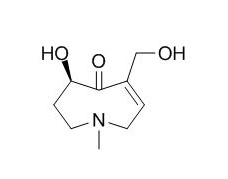Otonecine
Otonecine-type PA induces hepatotoxicity, the formation of an unstable pyrrolic ester plays a key role.
Inquire / Order:
manager@chemfaces.com
Technical Inquiries:
service@chemfaces.com
Tel:
+86-27-84237783
Fax:
+86-27-84254680
Address:
1 Building, No. 83, CheCheng Rd., Wuhan Economic and Technological Development Zone, Wuhan, Hubei 430056, PRC
Providing storage is as stated on the product vial and the vial is kept tightly sealed, the product can be stored for up to
24 months(2-8C).
Wherever possible, you should prepare and use solutions on the same day. However, if you need to make up stock solutions in advance, we recommend that you store the solution as aliquots in tightly sealed vials at -20C. Generally, these will be useable for up to two weeks. Before use, and prior to opening the vial we recommend that you allow your product to equilibrate to room temperature for at least 1 hour.
Need more advice on solubility, usage and handling? Please email to: service@chemfaces.com
The packaging of the product may have turned upside down during transportation, resulting in the natural compounds adhering to the neck or cap of the vial. take the vial out of its packaging and gently shake to let the compounds fall to the bottom of the vial. for liquid products, centrifuge at 200-500 RPM to gather the liquid at the bottom of the vial. try to avoid loss or contamination during handling.
PLoS One.2021, 16(6):e0248479.
Curr Issues Mol Biol.2024, 46(6):6018-6040.
Front Pharmacol.2020, 11:566490.
Sci Rep.2018, 8(1)
Cells.2023, 12(3):395.
J Korean Soc Food Sci Nutr2023, 52(12):1248-1255
Molecules.2019, 24(11):E2102
Molecules.2022, 27(22):7997.
Int J Mol Sci.2021, 22(21):11836.
J Chromatogr B Analyt Technol Biomed Life Sci.2019, 1126-1127:121743
Related and Featured Products
Chem Res Toxicol. 2004 May;17(5):702-8.
Metabolic formation of DHP-derived DNA adducts from a representative otonecine type pyrrolizidine alkaloid clivorine and the extract of Ligularia hodgsonnii hook.[Pubmed:
15144228]
Plants that contain pyrrolizidine alkaloids (PAs) are widely distributed, and PAs have been shown to be genotoxic and tumorigenic in experimental animals. Our recent mechanistic studies indicated that riddelliine, a tumorigenic retronecine type PA, induced tumors via a genotoxic mechanism mediated by the formation of a set of eight 6,7-dihydro-7-hydroxy-1-hydroxymethyl-5H-pyrrolizine (DHP)-derived DNA adducts. However, it is not known if this mechanism is general to PAs of other types.
METHODS AND RESULTS:
In this study, we report that the metabolism of clivorine, a tumorigenic Otonecine type PA, by F344 rat liver microsomes results in DHP formation. When incubations were conducted with clivorine in the presence of calf thymus DNA, eight DHP-derived DNA adducts were formed. The Ligularia hodgsonnii Hook plant, an antitussive traditional Chinese medicine, was found to contain Otonecine type PAs with clivorine being predominant. DHP and DHP-derived DNA adducts were also obtained when microsomal incubations were conducted with extracts of L. hodgsonnii Hook. This is the first report that DHP-derived DNA adducts are formed from the metabolic activation of Otonecine type PA and that these DHP-derived DNA adducts are potential biomarkers of PA exposure and PA-induced tumorigenicity.
CONCLUSIONS:
These results also provide evidence that the principal metabolic activation pathway of clivorine leading to liver genotoxicity and tumorigenicity is (i) formation of the corresponding dehydropyrrolizidine (pyrrolic) derivative through oxidative N-demethylation of the necine base followed by ring closure and dehydration and (ii) binding of the pyrrolic metabolite to DNA leading to the DNA adduct formation and tumor initiation.
Drug Metab Dispos. 2000 Dec;28(12):1475-83.
Characterization of rat liver microsomal metabolites of clivorine, an hepatotoxic otonecine-type pyrrolizidine alkaloid.[Pubmed:
11095586]
METHODS AND RESULTS:
The metabolism of the hepatotoxic Otonecine-type pyrrolizidine alkaloid (PA), clivorine, was investigated using rat liver microsomes. Furthermore, tissue-bound pyrroles were also determined to be present after microsomal incubation of clivorine. Clivoric acid has not been previously identified, and DHR and 7, 9-diGSH-DHR were found, for the first time, as metabolites of an Otonecine-type PA, while 7-GSH-DHR was previously reported by us to be a microsomal metabolite of clivorine.
CONCLUSIONS:
The present definitive identification of four pyrrolic ester-related metabolites of clivorine and indirect determination of bound pyrroles provide the strongest evidence to date to support the hypothesis that the formation of an unstable pyrrolic ester plays a key role in Otonecine-type PA-induced hepatotoxicity.



